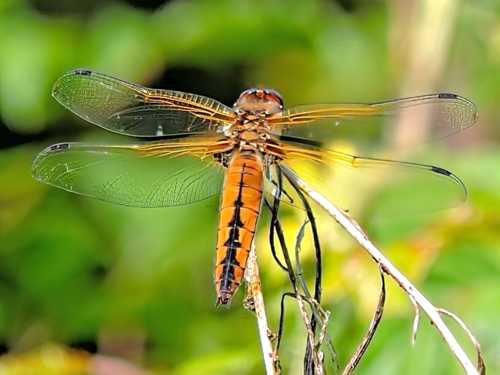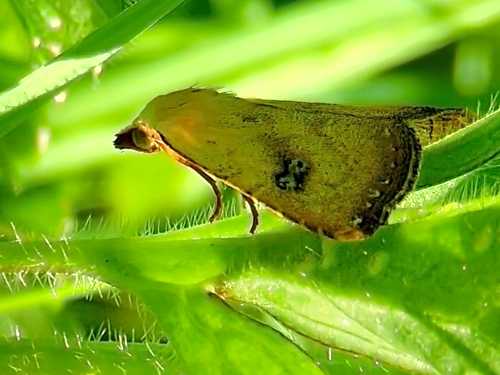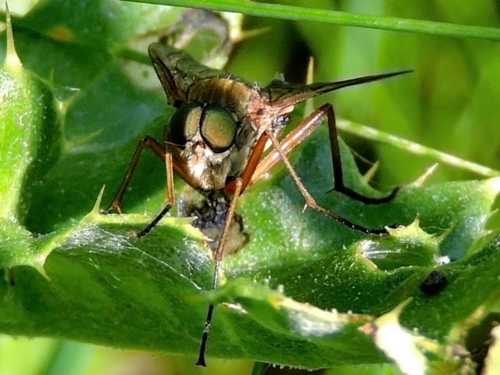Leader: Alvan White
Ten members gathered on a warm day with wall to wall sunshine. My appreciation is especially given for the expertise provided by Rob Randall (RR), Mike Williams (MW), and Alan Feest, although, as usual, all members contributed to the finds and group discussions.
Although called Carr’s Wood, the area can be divided into three: the former pasture land of Redland Park (grass now cropped around beginning of July); Carr’s woodland, covering the slopes; and the Newton Brook area that formerly held much botanical interest, but is now reverting to scrub and long grass.
Carr’s Wood itself has quite a few Wych Elms, and some leaves were examined to familiarise ourselves with the species. Although not seen, historically MW did see a White letter hairstreak hereabouts. Little was seen in the pitfall traps other than a Springtail. RR pointed out a woolly aphid species and the nibbling of a Beech leaf with the likely culprit curled up in its leaf retreat, an ideal specimen to take home and see what the larval stage develops into.
Redland Park is very deficient in botanical wonders. Nevertheless, Bramble was just starting to come out in flower, along with Bird’s Foot Trefoil and Lesser Trefoil. Much to my surprise a small patch of Yellow Rattle was found.
However Redland Park made up for that in the many insect species on the wing. Past years have produced a rich insect life, particularly with species using umbellifers for nectar.
Just inside the metal gate into the park, docks, nettles and parsley are prolific. The dock produced mating Dock Bugs, the nettles a robber fly species and Nursery Web Spiders, whilst the parsley provided Thick Kneed Flower Beetles (Oedemera nobilis) and Rustic Sailor Beetles (Cantharus rustica).

Immature Scarce Chaser (Libellula fulva), Newton Brook © Alvan White
There were many sightings of hawking Emperor Dragonflies (Anax imperator). Immature White legged damselflies (Platycnemis pennipes) were common around the open spaces. Amazingly, there was a dearth of the Demoiselles but an odd Beautiful Demoiselle (Calopteryx virgo) did make an appearance. A vivid orange Scarce Chaser (Libellula fulva) was observed hunting from its perch on the preceding reconnaissance, but none were seen on the day. The damselflies do breed along Newton Brook, and L. fulva along the nearby River Avon.
There was promise of Brown Argus butterflies. A potential mating pair was discovered. After much discussion and photography of the underwings this was confirmed. I found these down near Newton Brook a couple or so years ago. The food plant in a lot of reference books is stated to be Common Rock Rose. However the species is spreading and it now also uses geranium species (Butterflies of Sussex, Blencowe & Hulme). A small geranium species is plentiful in Redland.
Day flying moths were evident and included Gold Barred Longhorn (Nemophora degeerella), Yellow Shell (Camptogramma bilineata) and Silver Y (Autographa gamma). Straw Dot (Rivula sericealis) was seen on the lead up visit.
MW found a red-shouldered Longhorn beetle, and a small yellow and black parasitic wasp. Both were captured for later identification.

Straw Dot (Rivula sericealis), Redland Park © Alvan White

Probable Marsh Snipe Fly (Rhagio tringarius), Newton Brook © Alvan White
I found an unusual pair of flying insects. Both had unusual black upturned abdomens and blue eyes. Two sightings were made, but the insects flashed in and out of view, a mystery to be resolved in the future.
Great Spotted, and Green Woodpeckers and Song Thrush were heard. The site does not contain many warbler species, mainly Chiffchaff and Blackcap.
The area close to Newton Brook was explored and produced a young Slow worm (Anguis fragilis) under an old disposed tent. This followed on from the discarded tail of a slow worm found on the recce and thought to have been lost in a battle with a predator. It is thought that the easy losing of their tails is a defensive strategy. A young Woolly thistle plant was found, These are tall distinct thistles, typically growing in the Cotswolds and up to approximately 5 feet tall. The valley bottom can be very good for a number of insect species, the lead up visit produced a probable Marsh Snipe Fly.
At the finish a large species list was produced. It was very notable for the lack of butterfly species and numbers. However, a Comma, and Common Blue were seen, along with some white butterfly species.
This enjoyable meeting overshot the time specified, but could have been extended to hear and see some key birds on the arable land, at the other side of the valley. These include Yellowhammer, White throat and Lark.
Alvan White

Recent Comments